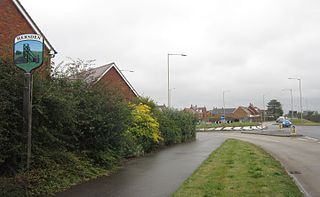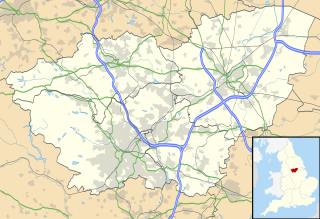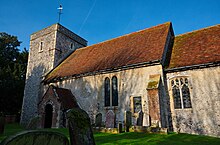
Eythorne is a civil parish and small village located 7.3 miles north-northwest of Dover in Kent, with a combined population of approximately 2,500 residents including nearby villages Barfrestone and Elvington. Although not classed as one of the former pit villages of Kent, it was only about a mile from Tilmanstone – which closed in 1986. Today many of its residents commute to work in Dover (Docks), or in Canterbury.

Dover is a local government district in Kent, England. The port town of Dover is its administrative centre. It was formed on 1 April 1974 by the merger of the boroughs of Deal, Dover, and Sandwich along with Dover Rural District and most of Eastry Rural District.

Royston is a suburban village within the Metropolitan borough of Barnsley, in South Yorkshire, England. Historically part of the West Riding of Yorkshire, but was incorporated into the Metropolitan borough of Barnsley in 1974 and is now on the border with West Yorkshire. It is part of the Barnsley Central borough constituency, and has a population of 9,375, increasing to 10,728 at the 2011 Census. It is situated 4 miles (6.4 km) north-east of Barnsley, and 6 miles (9.7 km) south-east of Wakefield.

Eastry is a civil parish in Kent, England, around 2+1⁄2 miles (4 km) southwest of Sandwich. It was voted "Kent Village of the Year 2005".

The East Kent Railway (EKR) is a heritage railway in Kent, England. It is located at Shepherdswell station on the London to Dover Priory direct mainline. The line was constructed between 1911 and 1917 to serve the Kent Coalfields. See East Kent Light Railway for details of the original lines. The Kent Collieries were mostly a failure with only Tilmanstone on the line producing any viable commercial coal and commercial traffic over the line. The line is operated by heritage diesel locomotives. It is home to a collection of heritage diesel locomotives, Diesel Multiple Units DMU, DEMU and an electric multiple units including an in service British Rail Class 404 built in the 1930s.

Wingham is a village and civil parish in the Dover District of Kent, England. The village lies along the ancient coastal road, now the A257, from Richborough to London, and is close to Canterbury.

Barfrestone is a village in East Kent, England, and between Shepherdswell, Eythorne and Nonington, and close to the pit villages of Elvington and Snowdown.

Elvington is a small pit village on a ridge in between Canterbury and Dover in the county of Kent in Southeast England. Located near Eythorne, Elvington was mostly built in the early 20th century to serve the nearby coal mine at Tilmanstone, as were other Kent Coalfield villages including Snowdown, Aylesham and Betteshanger.

Aylesham is a village and civil parish in the Dover district of Kent, England. The village is located around 6.5 miles (10.5 km) southeast of the cathedral city of Canterbury, and around 8.5 miles (13.7 km) northwest of the town and port of Dover. According to the 2001 Census, the parish had a population including Drellingore and Snowdown of 3,884, increasing to 3,999 at the 2011 Census.
The Kent Coalfield was a coalfield in the eastern part of the English county of Kent. The Coalfields Trust defines the Kent Coalfield as the wards of Barnham Downs and Marshside in the Canterbury district, and the wards of Aylesham, Eastry, Eythorne & Shepherdswell, Middle Deal & Sholden, Mill Hill and North Deal in the Dover district.

Ellistown is a village about 2 miles (3 km) south of Coalville in North West Leicestershire, England. It is named after Colonel Joseph Joel Ellis who died in 1885. The population from the 2011 census was included in the civil parish of Ellistown and Battleflat.

Dilhorne is an ancient parish and village in Staffordshire, three miles from Cheadle and six miles from Stoke-on-Trent. The village is within the Staffordshire Moorlands area.

Hersden is a village and civil parish east of Canterbury in Kent, South East England. It was established as a planned coalmining village in the 1920s and is on the A28 road between Canterbury and the Isle of Thanet. Work in the Kent Coalfield was the main source of employment in the village until the closure of the Kent colliery in the 1980s.

The Somerset Coalfield in northern Somerset, England is an area where coal was mined from the 15th century until 1973. It is part of a larger coalfield which stretched into southern Gloucestershire. The Somerset coalfield stretched from Cromhall in the north to the Mendip Hills in the south, and from Bath in the east to Nailsea in the west, a total area of about 240 square miles (622 km2). Most of the pits on the coalfield were concentrated in the Cam Brook, Wellow Brook and Nettlebridge Valleys and around Radstock and Farrington Gurney. The pits were grouped geographically, with clusters of pits close together working the same coal seams often under the same ownership. Many pits shared the trackways and tramways which connected them to the Somerset Coal Canal or railways for distribution.

The East Kent Light Railway was part of the Colonel Stephens group of cheaply built rural light railways in England. Holman Fred Stephens was engineer from its inception, subsequently becoming director and manager. The line ran from Shepherdswell to Wingham Station with a branch from Eastry through Poison Cross to Richborough Port. Built primarily for colliery traffic within the Kent Coalfields, the line was built with many spurs and branches to serve the mines, with cancelled plans to construct extensions to several others. The success of Tilmanstone colliery allowed the main line of the railway to continue operation until 1986. A remainder of the line became the East Kent Railway, a heritage railway, in 1987.

Betteshanger is a village near Deal in East Kent, England. It gave its name to the largest of the four chief collieries of the Kent coalfield. The population of the village is included in the civil parish of Northbourne.

The Ingleton Coalfield is in North Yorkshire, close to its border with Lancashire in north-west England. Isolated from other coal-producing areas, it is one of the smallest coalfields in Great Britain.
Fletcher, Burrows and Company was a coal mining company that owned collieries and cotton mills in Atherton, Greater Manchester, England. Gibfield, Howe Bridge and Chanters collieries exploited the coal mines (seams) of the middle coal measures in the Manchester Coalfield. The Fletchers built company housing at Hindsford and a model village at Howe Bridge which included pithead baths and a social club for its workers. The company became part of Manchester Collieries in 1929. The collieries were nationalised in 1947 becoming part of the National Coal Board.

The Miner's Way Trail is a long-distance circular footpath in England, starting at Sholden, Kent. Linking up the coalfield parishes of East Kent. Including; the parishes of Deal, Ash, Aylesham, Chillenden, Eastry, Eythorne, Elvington, Goodnestone, Nonington, Northbourne, Coldred, Staple, Tilmanstone and Wingham.

Barrow Colliery was a coal mine in Worsborough, South Yorkshire, England. It was first dug in 1873, with the first coal being brought to the surface in January 1876. It was the scene of a major incident in 1907 when seven miners died. After 109 years of coaling operations, the mine was closed in May 1985.





















